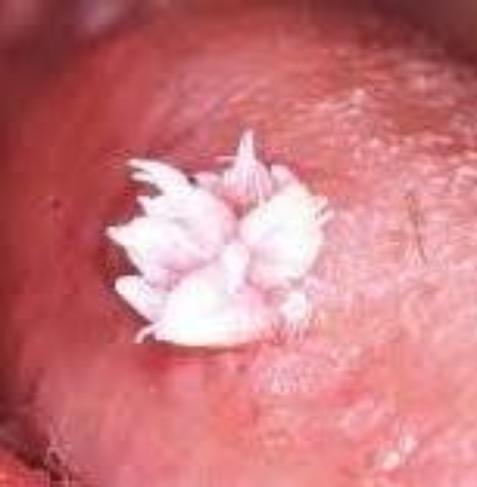Squamous Papilloma
What is a Squamous Papilloma?
Squamous papillomata (SP) are common warty growths found in the mouth (they account for 3 – 4% of all biopsied oral soft tissue lesions).
SP’s of the mouth occurs at all ages of life but is usually diagnosed in persons between 30 – 50 years of age.
There is no gender predilection and any surface of the mouth may be affected (most commonly though on the tongue, lips or cheek surfaces).
What is the Cause of a Squamous Papilloma?
Many are thought to be due to viral infection of the skin by the Human Papilloma Virus (HPV), a commonly occurring virus that is also responsible for the common wart (Verruca Vulgaris).
Whilst all HPV lesions are infective, the SP appears to have an extremely low virulence and infectivity rate; it does not seem to be contagious.
What are the signs and symptoms?
Typical presentation of the SP is of painless, solitary or multiple nodules measuring between 0.5cm to 3cm.
It is usually white but sometimes pink and has long or short surface projections with rounded or pointed ends. It often is on a stalk and only one lesion is usually found. Once present, it remains indefinitely.
How is it treated?
The SP is treated effectively by simple surgical excision or scraping (curettage) of the base of the SP and a small area of the surrounding normal tissue.
Alternative treatments include cryotherapy, topical application of keratinolytic agents (usually containing salicylic acid and lactic acid) or podophyllin or intra-lesional infiltration of α-interferon or imiquimod.
Recurrence is seen in a small proportion of treated cases.
Useful Articles & Websites
Brown Medical School, Digital Pathology
Marquette University School of Dentistry – Oral & Maxillofacial Pathology
ENT J 2000. Oral Squamous Papilloma. A View under Clinical, Fluorescence & Histopathological Aspects
J Egypt won Dermatol Soc 2008. Human Papilloma Virus & Squamous Cell Carcinoma of the Oral Cavity
Int J Oral Sci 2010. Squamous Papilloma – Case Report & Review of Literature
NEJM 2011. Images in Clinical Medicine. Human Papillomavirus Lesions of the Oral Cavity
BMJ Case Reports 2013. Images in…Oral Squamous Papilloma. Report of a Clinical Entity
J Stomat Occ Med 2013. Squamous Papilloma. Report of 2 Cases
Int J Dent Sci & Res 2014. Oral Squamous Papilloma of the Palate – A Case Report
Ind J Dent 2014. Case Report. Squamous Papilloma of the Hard Palate



